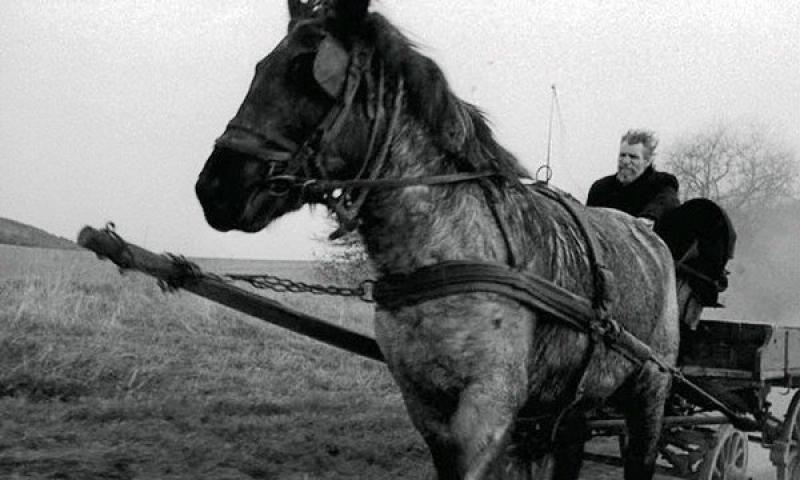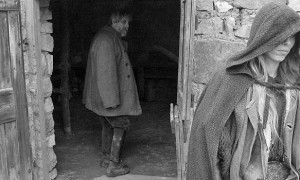The Turin Horse | reviews, news & interviews
The Turin Horse
The Turin Horse
In his monumental swansong, the Hungarian master Béla Tarr depicts daily struggle and impending apocalypse

The Turin Horse begins with a prologue in which a novelistic male narrator, talking over a black screen, describes the probably apocryphal incident that caused Friedrich Nietzsche to suffer a terminal mental breakdown (the more likely reason being syphilis). In a Turin plaza on 3 January 1889, the German philosopher supposedly saw a horse being whipped by a coachman and, sobbing, threw his arms around its neck.
In the indelibly poetic extended shot that follows, the first of the 30 that comprise the film, a frequently low-angled travelling camera moves toward and recedes from a similarly tormented beast of burden as it pulls a cart along a track in a misty rural landscape. It belongs to a carter in his late fifties, Ohlsdorfer (János Derzsi), who doesn’t realize that the horse is ailing. Béla Tarr, the film’s director, has said in interviews that he wanted to know what became of the horse that so moved Nietzsche to tears of compassion – and to a soul-destroying acceptance of ubiquitous cruelty and victimhood.
The terrified woman can be seen peering through the window as if she were already a ghost
There’s no need to speculate, however, that the poor creature would have had to trot across Bulgaria to reach the nearly treeless Hungarian valley where Ohlsdorfer subsists on a diet of potatoes and pálinka (fruit brandy) with his taciturn drudge of a daughter (Erika Bók, pictured below far right with Derzsi). Ohlsdorfer’s old mare, which he lashes with the reins when it won’t budge, is the Turin horse because Tarr wants it to be, its suffering the suffering of all who live in ceaseless silent misery. It has a secret sharer in the persecuted donkey of Robert Bresson’s 1966 Au Hasard Balthazar.
 Announced by the 56-year-old Hungarian master as his final film, The Turin Horse would appear to depict the reversal of God’s Seven Days of Creation. Showing the fate that befalls the Ohlsdorfers, who dwell penuriously in a spartan one-room farmhouse, over the course of the six days that provide the 154-minute movie with its chapters, it is a relentlessly sombre deconstruction of their humble eco-system, culminating in the woman's loss of will to survive and the disappearance of the light. In its invoking of apocalypse, albeit of the whimper rather than the bang variety, it is an austere analogue to Tarr’s more narratively complex and imagistic Werckmeister Harmonies (2000).
Announced by the 56-year-old Hungarian master as his final film, The Turin Horse would appear to depict the reversal of God’s Seven Days of Creation. Showing the fate that befalls the Ohlsdorfers, who dwell penuriously in a spartan one-room farmhouse, over the course of the six days that provide the 154-minute movie with its chapters, it is a relentlessly sombre deconstruction of their humble eco-system, culminating in the woman's loss of will to survive and the disappearance of the light. In its invoking of apocalypse, albeit of the whimper rather than the bang variety, it is an austere analogue to Tarr’s more narratively complex and imagistic Werckmeister Harmonies (2000).
For most of the movie, a gale rages, bombarding the air with debris. On the night of the first day, Ohlsdorfer notices, as they lay in their beds in the darkness, that the woodworms he has heard for 58 years have fallen silent. On the second day, the horse refuses to pull the cart. It subsequently neglects to eat, anticipating the woman’s later reaction to the disturbed atmosphere. The water in their well, on which they are wholly dependent, runs dry. They pack and leave, hitching the horse to a handcart holding their few belongings and dragging it after them. But there is nowhere to go, so they return. Back indoors, the terrified woman, filmed from outside, can be seen peering through the window as if she were already a ghost.
Although a cataclysm has evidently occurred in the part of the planet where they live, the film is less of an environmental storm warning than a spiritual one: What have we wrought? In the single scene containing a speech, a neighbour who has come to buy pálinka from Ohlsdorfer because the town is already a ruin rancorously decries the “they,” presumably the authorities – whether capitalistic, communistic, or clerical – who have debased everything. “Whatever man takes part in is the most ghastly creation you can imagine,” he rails. Ohlsdofer rubbishes this seemingly paranoid rant, which, however, bitterly echoes Nietzsche’s rejection of politics, Christianity, Judaism, and systems in general. The man’s invective against our capacity for destruction and incapability of change is not invalid because it issues from the mouth of a malcontent.
'Whatever man takes part in is the most ghastly creation you can imagine,' the neighbour rails
Much of The Turin Horse is taken up with repeated scenes, shot with minor variations, of the monotonous daily activities the father and daughter must carry out to survive. Because Ohlsdorfer’s right arm hangs limply at his side, the daughter must partially dress and undress him. Each morning, she fetches two buckets of well water. She prepares the same modest repast and they eat it, never speaking. He occasionally barks commands. They harness the horse to the cart, which Ohlsdorfer has presumably been driving into town every day for years to support them. They have no photographs, pictures, or means of entertainment. (A religious book is given her by some passing gypsies who stop by to take water from the well but its directive about sinning in church requiring penitence perplexes her, as well it might – “God,” said Nietzsche after all, “is dead.”)
If there is a point to Tarr showing these unavoidable rituals, likely to test the patience of many cinemagoers, it’s to emphasize that the daily grind is what makes up most people’s lives as they proceed, inch by inch, day by day, toward death. Underpinning the monotony, however, is the unspoken, unsentimental bond between the father and daughter. She lives with him because he could not cope without her. He is still her protector. His passionate Hungarian bigotry against the gypsies elicited by their impromptu visit, he rushes at them with his wood-chopper when they harass her. “We have to eat,” he insists when she, like the horse, gives up food. In that he resists the inevitable endgame, the irascible old carter is an oddly hopeful figure. Simply by being there in all his angry leonine thereness, like a Magyar Methuselah or Lot, he stands against the dying of the light, until nature drains his resolve, too.
Tarr worked with his usual collaborators: László Krasznahorkai wrote the script in novella form; Mihaly Vig composed the score, its one repeated motif ominously interlocking with the wind; Fred Kelemen shot the film in black and white. At times, the compositions have the stark and gloomy beauty of Bresson’s, though the images of the man and the woman filmed from behind as they stare hopelessly out of the window suggest Caspar David Friedrich’s paintings (minus their spectral Romanticism). It is a monumantal film with which to end a career, or a life. It leaves that sad old mare struggling gamely along the windswept track forever. The rest is silence.
Watch the trailer for The Turin Horse
rating
Share this article
Add comment
The future of Arts Journalism
You can stop theartsdesk.com closing!
We urgently need financing to survive. Our fundraising drive has thus far raised £49,000 but we need to reach £100,000 or we will be forced to close. Please contribute here: https://gofund.me/c3f6033d
And if you can forward this information to anyone who might assist, we’d be grateful.

Subscribe to theartsdesk.com
Thank you for continuing to read our work on theartsdesk.com. For unlimited access to every article in its entirety, including our archive of more than 15,000 pieces, we're asking for £5 per month or £40 per year. We feel it's a very good deal, and hope you do too.
To take a subscription now simply click here.
And if you're looking for that extra gift for a friend or family member, why not treat them to a theartsdesk.com gift subscription?
more Film
 The Mastermind review - another slim but nourishing slice of Americana from Kelly Reichardt
Josh O'Connor is perfect casting as a cocky middle-class American adrift in the 1970s
The Mastermind review - another slim but nourishing slice of Americana from Kelly Reichardt
Josh O'Connor is perfect casting as a cocky middle-class American adrift in the 1970s
 Springsteen: Deliver Me From Nowhere review - the story of the Boss who isn't boss of his own head
A brooding trip on the Bruce Springsteen highway of hard knocks
Springsteen: Deliver Me From Nowhere review - the story of the Boss who isn't boss of his own head
A brooding trip on the Bruce Springsteen highway of hard knocks
 The Perfect Neighbor, Netflix review - Florida found-footage documentary is a harrowing watch
Sundance winner chronicles a death that should have been prevented
The Perfect Neighbor, Netflix review - Florida found-footage documentary is a harrowing watch
Sundance winner chronicles a death that should have been prevented
 Blu-ray: Le Quai des Brumes
Love twinkles in the gloom of Marcel Carné’s fogbound French poetic realist classic
Blu-ray: Le Quai des Brumes
Love twinkles in the gloom of Marcel Carné’s fogbound French poetic realist classic
 Frankenstein review - the Prometheus of the charnel house
Guillermo del Toro is fitfully inspired, but often lost in long-held ambitions
Frankenstein review - the Prometheus of the charnel house
Guillermo del Toro is fitfully inspired, but often lost in long-held ambitions
 London Film Festival 2025 - a Korean masterclass in black comedy and a Camus classic effectively realised
New films from Park Chan-wook, Gianfranco Rosi, François Ozon, Ildikó Enyedi and more
London Film Festival 2025 - a Korean masterclass in black comedy and a Camus classic effectively realised
New films from Park Chan-wook, Gianfranco Rosi, François Ozon, Ildikó Enyedi and more
 After the Hunt review - muddled #MeToo provocation
Julia Roberts excels despite misfiring drama
After the Hunt review - muddled #MeToo provocation
Julia Roberts excels despite misfiring drama
 London Film Festival 2025 - Bradley Cooper channels John Bishop, the Boss goes to Nebraska, and a French pandemic
... not to mention Kristen Stewart's directing debut and a punchy prison drama
London Film Festival 2025 - Bradley Cooper channels John Bishop, the Boss goes to Nebraska, and a French pandemic
... not to mention Kristen Stewart's directing debut and a punchy prison drama
 Ballad of a Small Player review - Colin Farrell's all in as a gambler down on his luck
Conclave director Edward Berger swaps the Vatican for Asia's sin city
Ballad of a Small Player review - Colin Farrell's all in as a gambler down on his luck
Conclave director Edward Berger swaps the Vatican for Asia's sin city
 London Film Festival 2025 - from paranoia in Brazil and Iran, to light relief in New York and Tuscany
'Jay Kelly' disappoints, 'It Was Just an Accident' doesn't
London Film Festival 2025 - from paranoia in Brazil and Iran, to light relief in New York and Tuscany
'Jay Kelly' disappoints, 'It Was Just an Accident' doesn't
 Iron Ladies review - working-class heroines of the Miners' Strike
Documentary salutes the staunch women who fought Thatcher's pit closures
Iron Ladies review - working-class heroines of the Miners' Strike
Documentary salutes the staunch women who fought Thatcher's pit closures
 Blu-ray: The Man in the White Suit
Ealing Studios' prescient black comedy, as sharp as ever
Blu-ray: The Man in the White Suit
Ealing Studios' prescient black comedy, as sharp as ever

Comments
Mr Fuller is rather confused
"the probably apocryphal